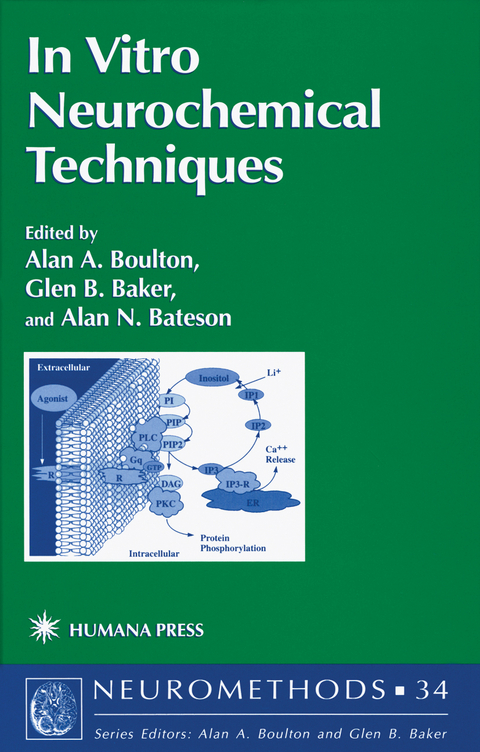
In Vitro Neurochemical Techniques
Seiten
1998
Humana Press Inc. (Verlag)
978-0-89603-509-6 (ISBN)
Humana Press Inc. (Verlag)
978-0-89603-509-6 (ISBN)
This volume provides comprehensive coverage of numerous "in vitro" methods regularly utilized by neuroscientists in their daily work. The methods are treated in-depth as each chapter opens by providing an overview of the method and description of its specific applications in the lab.
In Vitro Neurochemical Techniques is one of three volumes that rep- sent an update of the original Volume 1 of Neuromefkods, General Neu- chemical Techniques The expansion to three volumes was necessitated by the rapidly increasing number of techniques being used by neuroscrentists and the general tendency of neuroscience research to become more multidisciplrnary and collaborative in recent years. The two companion volumes are concerned primarily with In Vwo Neurometkods in one case, and with Cell Neurobiology Techniques in the other case. Even with three volumes, the coverage of General Neuvometkods is obviously not exhaustive. We have attempted to cover those techniques that seem particularly popular in multidisciplinary neuroscience research. Though some important techniques may have been omitted, we believe that most of these have been covered in detail in other recent volumes of Neurometkods or will be the subjects of upcommg volumes The editors anticipate that these volumes will prove unusually useful to neuroscientists across a wide range of fields-e.g., neurochemistry, neuropsychopharmacology, neurology, psychiatry, and neuroanatomy.
Each chapter has been written by well-known neuroscientists with - tive research programs. Experienced researchers in the specific areas treated will appreciate the present updates on those topics, and neuros- entists expecting their research programs to become more multidisciplinary or to expand into new areas of research should find these volumes of enormous value, particularly those sections offering protocols with u- ful hints about the advantages and potential pitfalls of a particular te- nique.
In Vitro Neurochemical Techniques is one of three volumes that rep- sent an update of the original Volume 1 of Neuromefkods, General Neu- chemical Techniques The expansion to three volumes was necessitated by the rapidly increasing number of techniques being used by neuroscrentists and the general tendency of neuroscience research to become more multidisciplrnary and collaborative in recent years. The two companion volumes are concerned primarily with In Vwo Neurometkods in one case, and with Cell Neurobiology Techniques in the other case. Even with three volumes, the coverage of General Neuvometkods is obviously not exhaustive. We have attempted to cover those techniques that seem particularly popular in multidisciplinary neuroscience research. Though some important techniques may have been omitted, we believe that most of these have been covered in detail in other recent volumes of Neurometkods or will be the subjects of upcommg volumes The editors anticipate that these volumes will prove unusually useful to neuroscientists across a wide range of fields-e.g., neurochemistry, neuropsychopharmacology, neurology, psychiatry, and neuroanatomy.
Each chapter has been written by well-known neuroscientists with - tive research programs. Experienced researchers in the specific areas treated will appreciate the present updates on those topics, and neuros- entists expecting their research programs to become more multidisciplinary or to expand into new areas of research should find these volumes of enormous value, particularly those sections offering protocols with u- ful hints about the advantages and potential pitfalls of a particular te- nique.
Characterization of Receptors by Radiolabeled Ligand-Binding Techniques.- Electrophysiological Studies on Receptors In Vitro.- Subtractive Hybridization.- Messenger RNA Differential Display.- Localization of mRNAs in Brain Sections by in situ Hybridization Using Oligonucleotide Probes.- Multiprobe Oligonucleotide Solution Hybridization for the Determination of Relative mRNA Levels.- Competitive RT-PCR to Quantitate Steady-State mRNA Levels.- A Novel PCR-RFLP Detection Method Using an Optimized Set of Restriction Enzymes.- Western Blot Analysis.- The Phosphoinositide Signal Transduction System.- Protein Phosphorylation.- Immunoprecipitation of Receptors.
| Erscheint lt. Verlag | 6.11.1998 |
|---|---|
| Reihe/Serie | Neuromethods ; 34 |
| Zusatzinfo | XIV, 296 p. |
| Verlagsort | Totowa, NJ |
| Sprache | englisch |
| Maße | 155 x 235 mm |
| Themenwelt | Medizin / Pharmazie ► Medizinische Fachgebiete ► Laboratoriumsmedizin |
| Medizin / Pharmazie ► Studium | |
| Naturwissenschaften ► Biologie ► Genetik / Molekularbiologie | |
| Naturwissenschaften ► Biologie ► Humanbiologie | |
| Naturwissenschaften ► Biologie ► Zellbiologie | |
| Naturwissenschaften ► Biologie ► Zoologie | |
| ISBN-10 | 0-89603-509-3 / 0896035093 |
| ISBN-13 | 978-0-89603-509-6 / 9780896035096 |
| Zustand | Neuware |
| Informationen gemäß Produktsicherheitsverordnung (GPSR) | |
| Haben Sie eine Frage zum Produkt? |
Mehr entdecken
aus dem Bereich
aus dem Bereich
Buch | Softcover (2021)
Deutscher Ärzteverlag
29,99 €
ein praxisorientiertes Handbuch
Buch | Hardcover (2023)
Wiley-VCH Verlag GmbH
49,90 €


